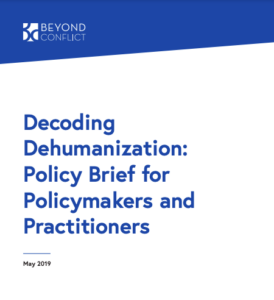A New Approach to Target Dehumanization
Over the last five years, Beyond Conflict and its scientific partners have sought to understand the psychological processes and brain mechanisms involved in dehumanization. We are now pleased to share our findings and their real-world applications with you. Dehumanization – the perception of others as less than human – has accompanied the darkest chapters of human history. Emerging scientific knowledge on blatant dehumanization and its link to group-targeted harm now offers a new approach to target dehumanization and develop more effective violence prevention interventions.
1) In every cultural context surveyed, at least one group was significantly dehumanized, and in every case, the degree of dehumanization expressed by individuals was strongly associated with support for identity-based hostility. For example, blatant dehumanization was associated with support for a policy that provides Roma women with contraceptives that have a high chance of permanent sterilization; opposition to the peace deal with FARC among Colombians, and support for punishment of FARC members’ children; and comfort with civilian casualties among Israelis and Palestinians.
2) Discriminatory behavior towards outgroups is better predicted by blatant dehumanization than by prejudice. Using functional MRI which detects the activation patterns of different regions of the brain, we have identified the neural mechanisms underlying blatant dehumanization. These mechanisms are distinct from those underlying dislike. This has practical implications because many programs aimed at preventing discrimination and mass atrocities focus on approaches targeted at reducing prejudice between groups instead of dehumanization. Take, for example, the policies that forcibly removed Native American children from their families in order to “civilize” them. These policies were informed by people who cared for Native children (low level of prejudice), but who simultaneously believed them fundamentally inferior to their own group (high level of dehumanization).
3) Meta-dehumanization – or the perception that other groups see you or your group as less than human – can predict the surveyed group’s dehumanization of other groups and intergroup hostility. Meta-dehumanization offers great promise for tracking dehumanization among elite decision-makers because, in general, people are more likely to share their perspective on other people’s perspectives than they are to likely share their own.

In light of these findings, we believe there are at least four potential applications that policymakers and practitioners can consider:
- Improved early-warning systems – By systematically tracking blatant dehumanization among relevant groups (using nationally representative surveys) and elites (using more targeted conversational techniques), we can track an important potential risk factor that is currently not accounted for in most early warning systems.
- Strategic messaging interventions – Building upon the precursors to dehumanization, we can build evidence-based messaging interventions aimed at countering dangerous speech and dehumanizing rhetoric. As often people believe themselves to be more dehumanized by others than they actually are, challenging these meta-perceptions offers us a basis on which to intervene.
- Monitoring and evaluation – Using the blatant dehumanization scale, as well as other measures, we could better quantify and measure programmatic efforts aimed at promoting reconciliation, preventing violence, and reducing discrimination.
- Training for diplomats and practitioners – Creating training modules about the early detection of dehumanization in field settings, as well as training in techniques to reduce dehumanization, would be helpful to diplomats and practitioners in field settings.
